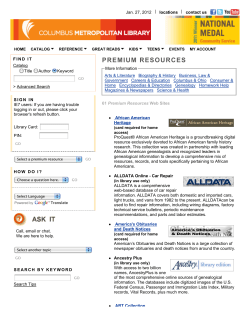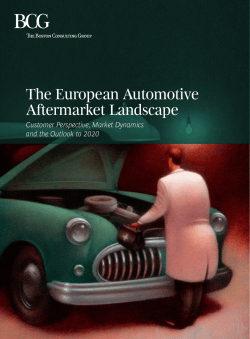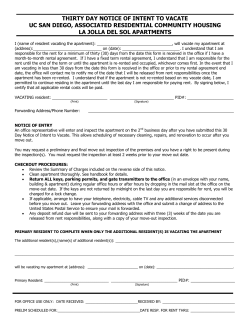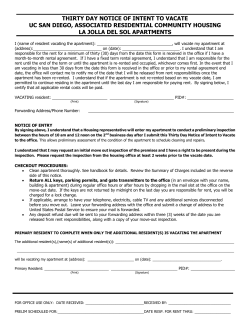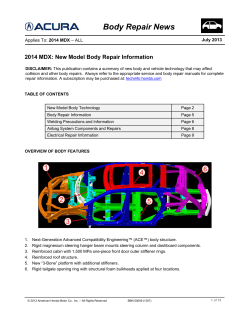
Auto Repair Shops Industry Snapshot
Auto Repair Shops Industry Snapshot 119 North Commercial Street, Suite 195 Bellingham, WA 98225‐4455 phone: (360) 733‐4014 fax: (360) 733‐5092 www.cevforbusiness.com Industry Segments The following chart breaks down the segments within the auto repair industry. 1 Industry Segments 5.70% 2.00% 6.70% General Automotive Repair Automotive Transmission Repair & Maintenance All Other Repairs Automotive Exhaust Repair 85.60% General automotive repair This segment has grown as a percentage of overall industry revenue in the past five years, and is expected to increase. Businesses that make up this segment provide all inclusive services. These services include: diagnostics, alternator and starter rebuilding, no‐start and drivability, fuel injection cleaning, timing belt change, tune‐up, clutches, brake service, plus many other services. It is reported that each year the average repair shop replaces between 25 to 30 engines. Automotive transmission Included in this category is: hydraulic, electronic, and computer systems. This segment is expected to maintain its current percentage of the market segment for the next five years. Automotive exhaust repair This segment is made up of mechanics who specialize in the repair and installation of automotive exhaust systems. Over the past five years this segment has been contracting as a result of improved technologies. Non‐corrosive stainless steel parts have extended the lives of parts in exhaust systems approximately 10 years and that has decreased the need for repairs. Other repairs Other repairs include: tune‐ups, tire retreading, automotive electrical repair, fuel system conversion, battery and ignition repair, and generator and starter repair. Approximately 17.2% of other repairs come from radiator repairs. 1 IBISWorld Pty Ltd., “Auto Mechanics in the US.” New York: IBISWorld. March 15, 2010. http://www.ibisworld.com Center for Economic Vitality Page 1 Industry Data Body Shop Business Monthly provides industry data on operating costs for repair shops. 2 The following chart shows annual gross income and the percentage of repair shop owners reporting that income. Annual Gross Sales Volume 26% $1 Million or more 10% $750,000 to $1 Million 20% $350,000 to $749,999 10% $250,000 to $349,999 34% Less Than $249,999 0% 10% 20% 30% 40% The chart below estimates the breakdown of purchase dollars for shops. The average shop spends $2,500 a month on paint. Of all automotive repair shop, 91% own some type of computerized estimating system, 50% own a computerized measuring system, and own a 35% own a crossdraft spraybooth. 3 % of Purchasing Dollars Spent on: Paint 6% 8% 4% Crash Parts 21% 7% Refinishing Materials 8% Repair Materials 31% 15% Tools Capital Equipment Mechanical Parts Other 2 “Industry Statistics,” BodyShop Business, http://www.bodyshopbusiness.com/IndustryStatistics.aspx (April 23, 2010). 3 Ibid Center for Economic Vitality Page 2 Average Annual Salary Metal Technicians $48,973 Painters $51,720 Mechanics $44,478 Entry Level Employees $28,342 Office Managers $38,132 Senior Estimators $56,365 The table above breaks down average salary for auto repair shops in the U.S. Sixty‐five percent of shops have at least one employee who has been employed with them for more than twenty years. Below is a list of some of the fringe benefits offered by some shops: • 77% of shops offer medical coverage • 65% of shops offer uniforms • 93% of shops offer paid vacations • 67% of shops offer paid training and education • 28% of shops offer a 401K plan • 13% of shops offer a vision plan • 33% of shops offer paid sick days • 16% of shops offer profit sharing Success Factors 4 Achieving Economies of Scale Businesses that are successful in achieving economies of scales, especially in distribution costs and advertising prove to be the most successful. Workplace Safety Successful businesses focus on maintaining safe working conditions and its corporate image revolves around safety and environment consciousness. Strong Inventory Management Skills Strong businesses are able to control stock on hand and install accurate costing systems. Employment of Skilled Automotive Technicians It is important to have access to a skilled workforce as vehicles are becoming more technologically advanced and complicated. 4 IBISWorld Pty Ltd., “Auto Mechanics in the US.” New York: IBISWorld. March 15, 2010. http://www.ibisworld.com Center for Economic Vitality Page 3 Provide Superior after Sales Service and Support This segment can be extremely competitive, so superior customer service is extremely important. Obtain Most Recent Repair and Technology Information To gain repeat customers, businesses need to have access to repair information from the original equipment manufacturer. Located Close to Key Markets The size and location of the business is essential to its success. The location will determine the potential market size and indicates average customers income, vehicle count, population, and competition. Risks and Challenges Insurance Dependence Insurance direct repair programs can make‐up nearly all of a shop’s revenue. Some shops feel forced to conform to insurance demands and suggestions to install cheaper aftermarket parts at certain billable rates, to maintain the sales levels and business they are used to. Repair Information Controlled by Car Makers Onboard diagnostic systems can hinder technicians from making appropriate repairs. Technicians are required to have special equipment and information to repair certain parts and problems. In some cases, car makers release information first to their own car dealers. Car Dealer Competition Modern cars have become more complex requiring technically proficient repair shops. The parts department in many dealerships has become more profitable than the sales department. If customer service is performed well during the warranty phase, there is an increased chance that the client will return for additional repair and maintenance when the warranty expirers. Turnover of Personnel There is a great demand for experiences technicians. Turnover remains high in many companies despite the incentives many businesses are using to keep trained staff around. Special Handling Requirement for New Materials Non‐traditional material use has become a challenge for many repair shops. Trained staff, special tools, and in some case certification are required for the repair of vehicles using certain material; like aluminum. Center for Economic Vitality Page 4 Trends 5 Decreasing Number of Car Accidents With increased vehicle safety, milder weather and fewer miles driven, the demand for auto repair has slowed and auto shops have begun to struggle. Evolving Service Offerings As vehicles parts become more durable, shops focus on light repair and expand service offerings. Customers who once did work themselves are forced to go to a shop because of the growing complexity in new vehicles. Growing Need for Certification Insurance companies are beginning to require the certification of repair shop technicians. The most common certification currently is Automotive Service Excellence (ASE). Trends Evolving in Driving Driving habits have changed for consumers due to record high gas prices. After more than a decade of growth, total traffic volume decreased between 2007 and 2008. Anti‐Steering Legislation Some states have considered passing laws to prevent insurance companies from “steering” business to large auto repair shops. This causes smaller independent businesses to lose revenue. Insurance companies refuse to pay more than prevailing rate, and many shops believe they are at fault for depressing labor rate and prevent small shops from being profitable. Consumer Demographics or Expenditures According to the Household Spending guide, the following are consumer demographics for vehicle maintenance and repair in 2007: 6 • Those ages 35 to 44 are ten times more likely to than the average person to spend money on vehicle maintenance and repair. Annually, the average person in this segment spends $805 on these services. • Those ages 45 to 54 are twenty‐eight times more likely to than the average person to spend money on vehicle maintenance and repair. Annually, the average person in this segment spends $941 on these services. • Those ages 55 to 64 are ten times more likely to than the average person to spend money on vehicle maintenance and repair. Annually, the average person in this segment spends $885 on these services. 5 First Research, Inc. 2007, “Automotive Repair Shops.” Austin, TX: First Research. January 25, 2010. http://www.firstresearch.com. Our subscription to this service is possible through donations made by Metcalf Hodges and Wells Fargo Bank. 6 Household spending: who spends how much on what. 1997. Ithaca, N.Y.: New Strategist Publications. Center for Economic Vitality Page 5 • Married couples are 36 times more likely than the average person to spend money on vehicle maintenance and repair. Annually, the average person in this segment spends $1,010 on these services. • A single person is 36 times less likely than the average person to spend money on vehicle maintenance and repair. Annually, the average person in this segment spends $621 on these services. Financial Information The financials of small and large companies are used to establish industry averages for several items on the income statement, balance sheet and financial ratios. Small companies included those with sales less than $729,228 annually; a total of 267 small businesses were surveyed. Companies with sales greater than $729,228 were considered large auto repair shops. There were a total of 1068 large auto repair shop financials collected. The below table is based off information from First Research and can be used as a benchmark against the financials of any auto repair shop. 7 Company Benchmark Information Small Company 100% 51.20% 4.10% 2.80% Aggregate 100% 48.10% 3.90% 2.30% Small Balance Sheet Company Cash 9.40% Accounts Receivable 5.60% Inventory 9.00% Total Current Assets 24.40% Total Fixed Assets 31.80% Other Non‐Current Assets 43.80% Total Assets 100% Accounts Payable 5.90% Total Current Liabilities 39.50% Total Long‐Term Liabilities 5.20% Net Worth 55.30% Aggregate 8.40% 13% 13.30% 36.10% 23.40% 40.50% 100% 9.20% 36.70% 7.70% 55.50% Income Statement Net Sales Gross Profit Operating Income Net Profit After Tax 7 First Research, Inc. 2007, “Automotive Repair Shops.” Austin, TX: First Research. January 25, 2010. http://www.firstresearch.com. Our subscription to this service is possible through donations made by Metcalf Hodges and Wells Fargo Bank. Center for Economic Vitality Page 6 Financial Ratios Quick Ratio Current Ratio Current Liabilities to Net Worth Current Liabilities to Inventory Total Liabilities to Net Worth Fixed Assets to Net Worth Collection Period Inventory Turnover Assets to Sales Sales to Working Capital Accounts Payable to Sales Return on Sales Return on Assets Return on Investment Interest Coverage Small Company 0.84 1.84 Aggregate 0.89 1.76 14.50% 42.0% 152% 155.50% 31.50% 19% 7.70% 21.30% 32% 4.50% 2% 3% 7% 34% 4.40% 69% 32% 15.10% 18.60% 29% 7.40% 3% 2% 6% 23% 6% Websites The following websites are great resources for industry trends, statistics, news, networking connections, trade shows, events, and articles. Automotive Service Association http://www.asashop.org/ Automotive Body Repair News http://abrn.search‐autoparts.com/ Professional Tool and Equipment News http://www.pten.com/ BodyShop Business http://www.bodyshopbusiness.com/ Bureau of Transportation Statistics http://www.bts.gov/ Center for Economic Vitality Page 7
© Copyright 2025



